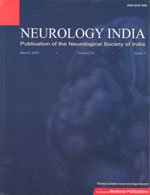
|
Neurology India
Medknow Publications on behalf of the Neurological Society of India
ISSN: 0028-3886 EISSN: 1998-4022
Vol. 52, Num. 2, 2004, pp. 271-271
|
Neurology India, Vol. 52, No. 2, April-June, 2004, pp. 271
Letter To Editor
Authors' Reply
Ashalatha R, Kishore A, Sarada C, Nair MD
Consultant in Neurology, Sree Chitra Tirunal Institute for Medical Sciences and Technology, Trivandrum - 695011, Kerala
Correspondence Address:Consultant in Neurology, Sree Chitra Tirunal Institute for Medical Sciences and Technology, Trivandrum - 695011, Kerala
drashalatha@sctimst.ker.nic.in
Code Number: ni04088
Sir,
We Dr. Varkey for the interest in our case report on Satoyoshi syndrome[1]. We are aware of the very recent publication of Drost et al., of anti GAD antibodies in Satayoshi syndrome[2]. Interestingly, unlike our patient, the case reported by them did not have any of the typical features of Satayoshi syndrome such as short stature, bony deformities, glucose intolerance, jaw muscel spasms etc. which were reported by Satayoshi. But for the age of onset, the case could have easily been called stiff person syndrome, a condition where 65% patients could have antiGAD antibodies. We agree that if the test were positive in a more typical case such as ours, it would add more strength to the presumed autoimmune etiology of the condition as well as the suggestion of Drost et al., that Satayoshi syndrome and Stiff person syndrome could both be different clinical expressions of a spinal hyperexcitiatibily state in different age groups. We will pursue the same.
References
| 1. | Ashalatha R, Kishore A, Sarada C, Nair MD. Satayoshi syndrome. Neurol India 2004;52:94-5. Back to cited text no. 1 [PUBMED] [FULLTEXT] |
| 2. | Drost G, Verrips A, Hoojikaas H, Zwarts M. Glutamic acid decarboxylase antibodies in SAtayoshi syndrome. Ann Neurol 2004;55:450-1. Back to cited text no. 2 |
Copyright 2004 - Neurology India
|
